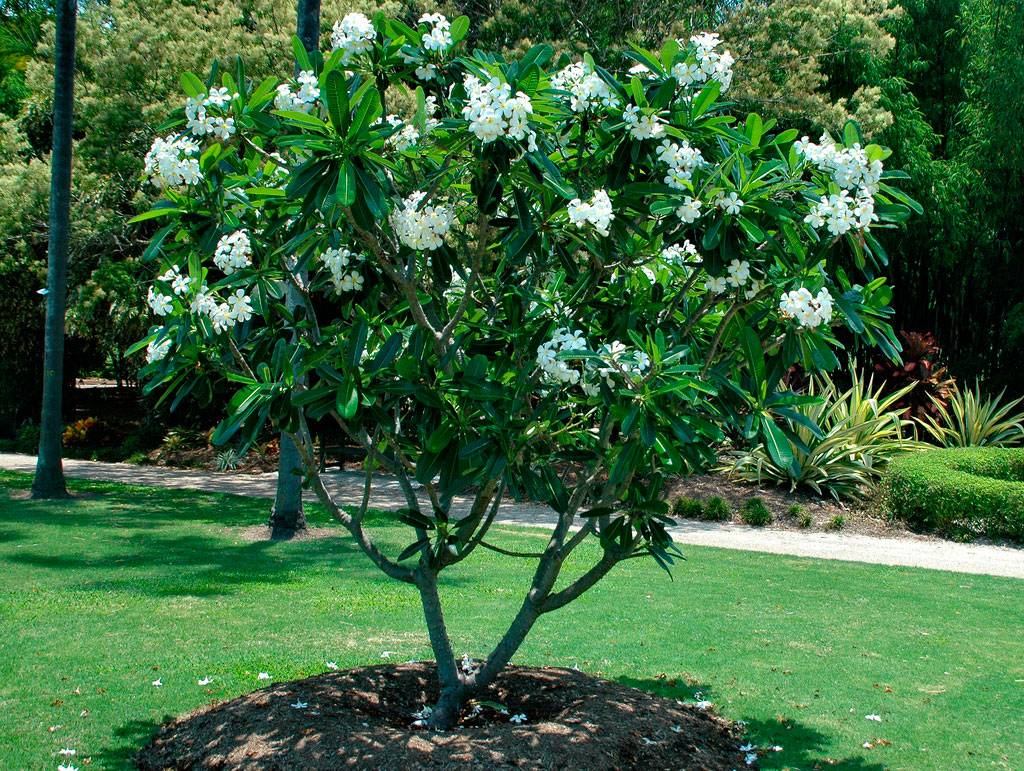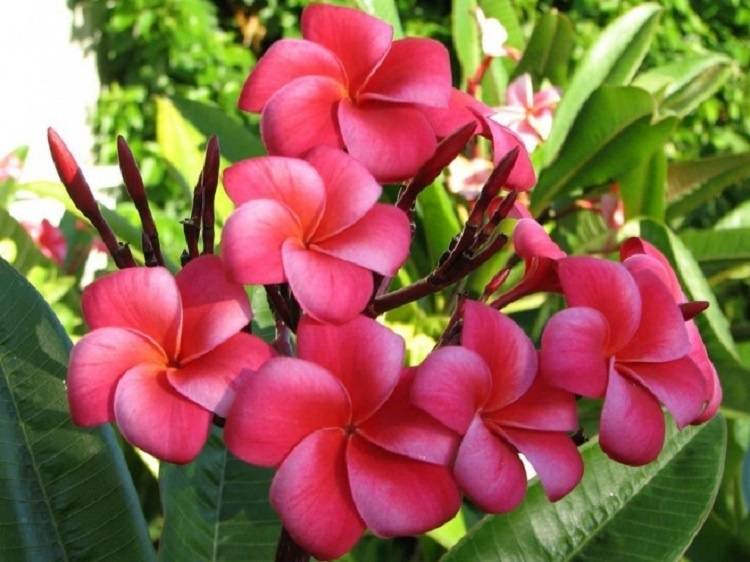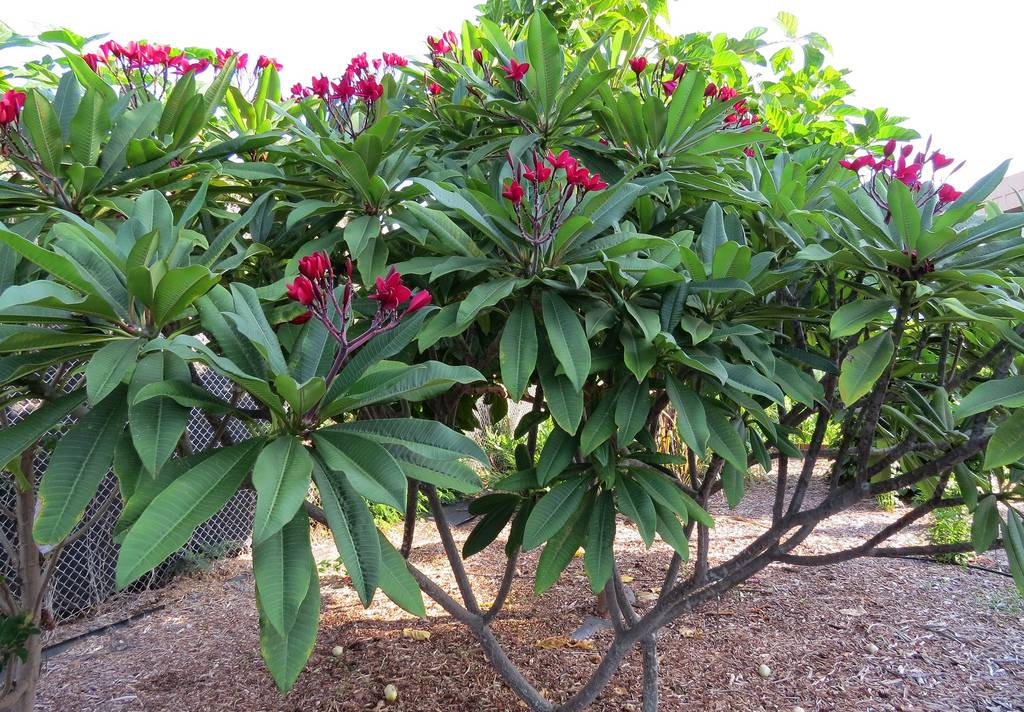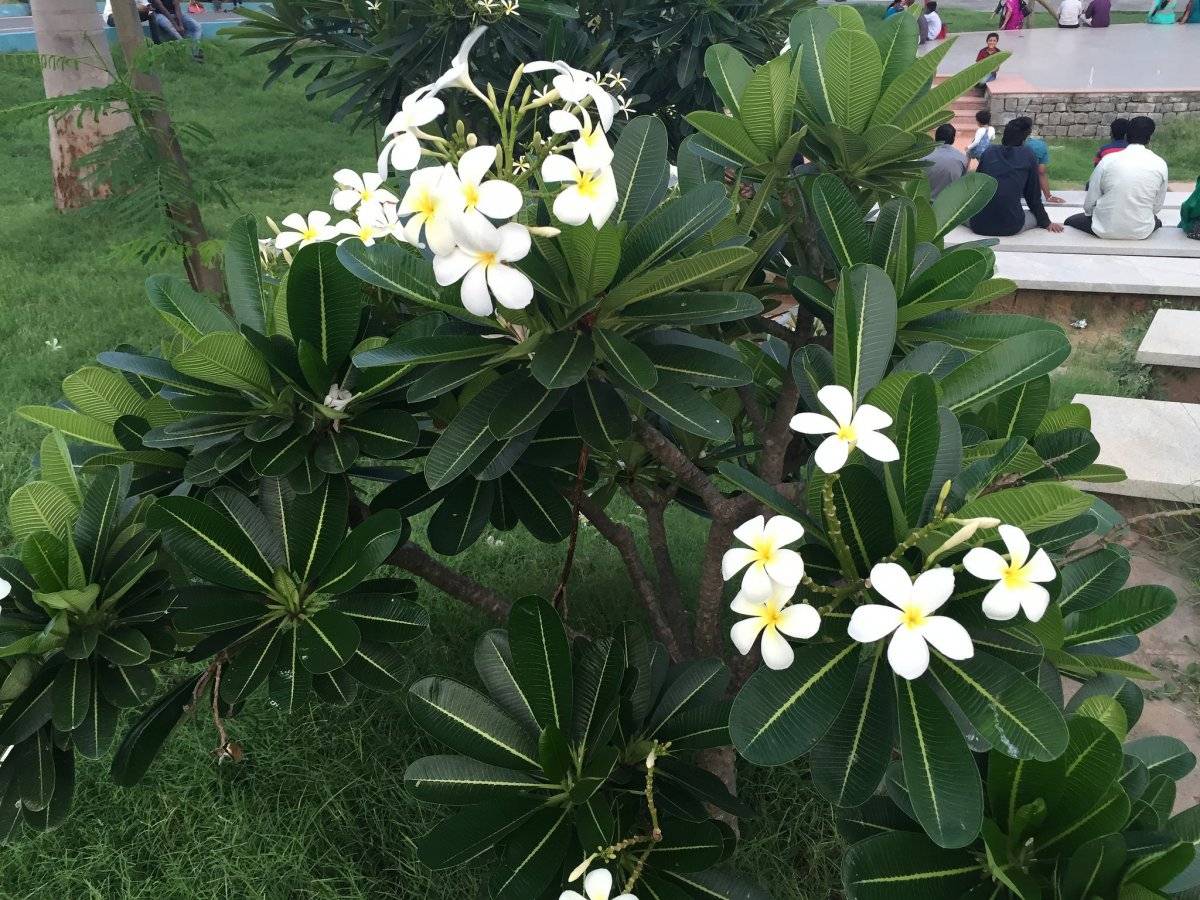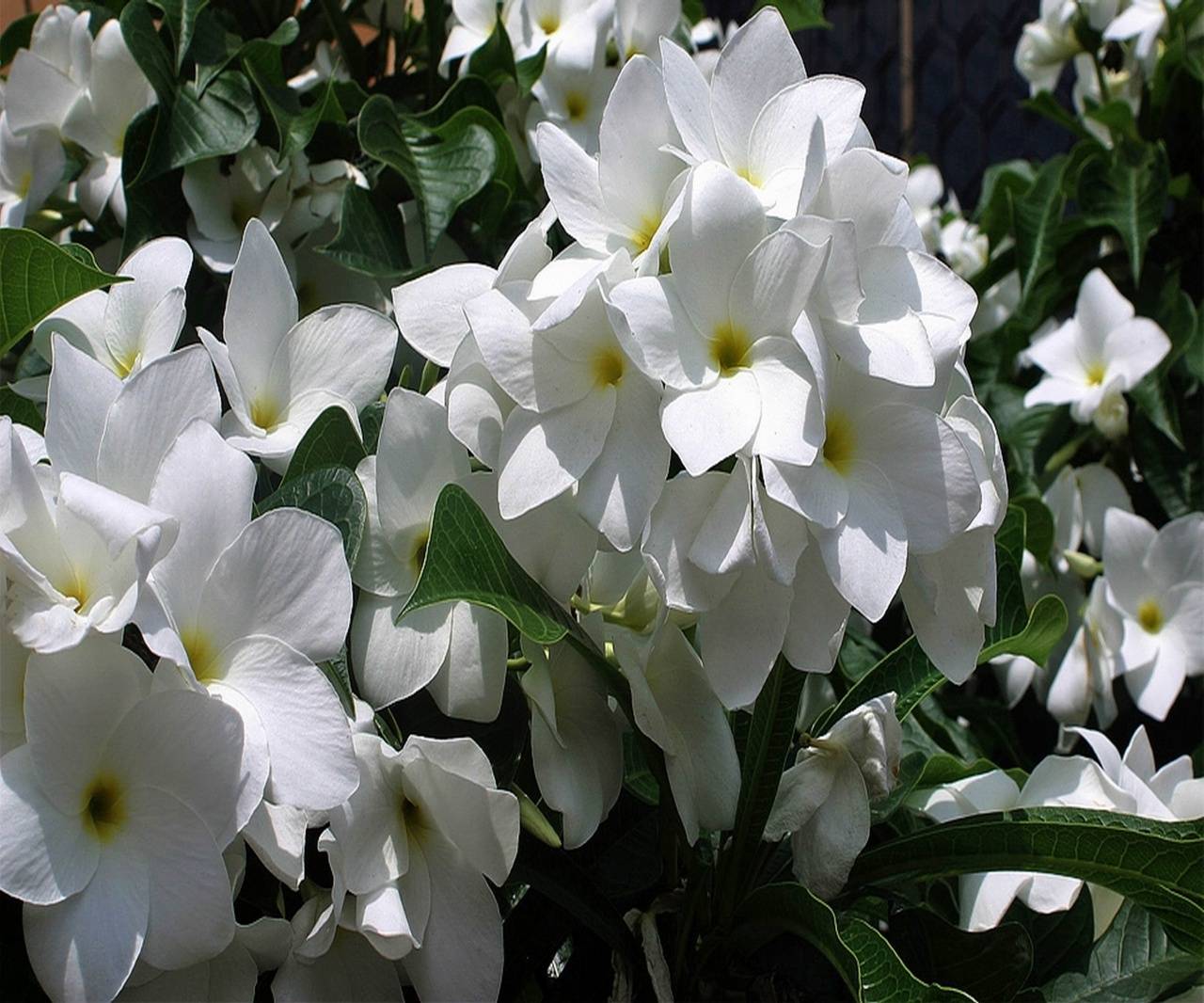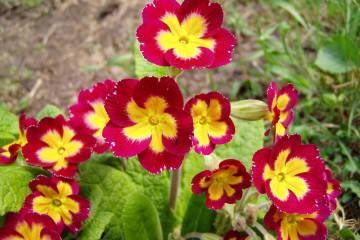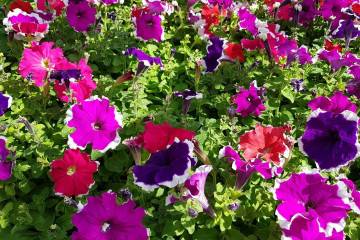Plumeria: home care and breeding methods
Content:
Plumeria belongs to the category of deciduous plants that are a member of the Kutrov family. Perennial culture during the flowering period looks very impressive. The delicate aroma emanating from the inflorescences spreads throughout the room. When growing a shrub at home, its height can exceed 190-210 cm. Plumeria, which is easy to care for at home, can decorate any interior.
History and description
Plumeria was named after the famous botanist Charles Plumier, who was born in France. According to legend, the French traveler set out to find wealth. A gypsy woman who met on the way advised him to find a tree that grows near churches and cemeteries. The flowers of this tree, the meaning of which is to purify the air, are colored in the color of the moon.
The fortune teller foreshadowed the Frenchman the wealth he would receive by finding a fragrant flower. During a trip to the West Indies, a botanist found this culture. The amazing aroma of the bush, which managed to bloom, liked the traveler so much that he realized what exactly his wealth was. After all, the peace and tranquility of nature is the wealth of every person living on this planet.
For your information! In addition to its enchanting aroma, plumeria has an extraordinary ability not to burn even at temperatures of 450-490 ° C.
Plumeria flowers have 5 petals. The amazing aroma of the plant intensifies in the early morning at sunrise. The smell may change depending on the environment. The petals are oval. They can curl or be completely flat. The pronounced aroma of the inflorescences attracts insects. However, they look in vain for nectar by pollinating flowers. On dark green leaf plates, an admixture of a purple hue is observed. The foliage is elliptical. The shade of flowers that appear on the branches when the shrub begins to bloom can be:
- pink;
- red;
- yellow;
- white.
Plumeria oil extract is used in cosmetology. The product is endowed with anti-inflammatory, antioxidant and regenerating effects. Often, manufacturers use an oil extract in the process of making a night cream for the skin, which helps cleanse the epithelium.
After the end of the flowering period, narrow pods resembling the shape of a cylinder are formed on the bushes, which sharpen towards the end. The pods are colored green or reddish brown. The fruits of the decorative culture are inedible.
The harvested seed should be stored in a cool dry place. It should be planted for the next season, since the long storage period reduces the germination of seeds.
Common varieties
Below are the most popular plumeria varieties among flower growers.
- Blunt Plumeria is an evergreen shrub whose height reaches 300-500 cm. Semi-dwarf varieties of blunt plumeria do not exceed 140-150 cm. The length of the branches of compact indoor flowers is within 35-40 cm. Dark green leaf plates are velvety to the touch. On the reverse side, they are covered with a small fluff, painted in a gray-green palette. The length of the leaf plates reaches 18-20 cm. The flowers consist of 5 petals, painted in a white shade. They are collected on elongated peduncles.The extreme parts of the petals, half of which are painted in bright yellow shades, are bent back. The pleasant scent of dull plumeria contains notes of jasmine.
- White plumeria is a flower native to the Caribbean islands. The main distinguishing feature of the medium-high variety is the complete loss of green mass during the dormant period. Smooth leaf plates on the upper side are painted in a dark green tint, and the reverse side is silver. The leaves are close together. In the central part of each flower, a pale yellow eye of a small size is visible. The pedicel of the white variety is short. White plumeria will effectively decorate any interior.
- Red plumeria is a shrub, the leaves of which are sharpened at the ends. During flowering, the bushes are literally dotted with flowers painted in red tones. Large-sized flowers are collected in several pieces. Some inflorescences consist of 15-25 flowers.
Home care
By properly caring for the crop, you can grow a healthy plant that will delight every year with a gorgeous flowering.
Lighting
Plumeria, like rhododendron, belongs to the category of light-loving plants. Experts recommend placing flower pots near windows on the south side. Every day, the culture should be illuminated in direct sunlight for at least 6 hours. Otherwise, flowering will not occur. You can also place the containers on the windowsills on the west or east side. In the summer, it is advisable to put flowerpots on the balcony or take them out into the garden. On especially hot summer days, it is better to shade the houseplant with a special garden net to avoid sunburn on the leaf plates.
Important! Do not allow rain drops to hit the green mass of the ornamental culture. It is also worth protecting the plant from drafts.
Temperature regime
Plumeria is a thermophilic culture. From mid-March to the very end of summer, the room temperature should be in the range of 26-30 ° C. In autumn, the temperature regime should be slightly reduced, and with the onset of spring, a decrease in temperature to 18 ° C is permissible.
Watering features
In the cold season, the soil is moistened as the topsoil dries out. For this purpose, it is recommended to use soft, settled water. In the warm season, the soil is moistened every 2 days. However, it is important to ensure that the soil is not waterlogged. Against the background of waterlogging, the risk of decay of the root system increases. On cloudy days, you can skip watering.
Humidity
During the period of active growth, plumeria (frangipani) needs systematic spraying. For this purpose, it is recommended to use soft, settled water. To help increase the level of humidity, it is recommended to fill the pallets with a layer of expanded clay, which must be pre-moistened. The soil on the surface of the bottom of the container should not come into contact with the liquid in the pan.
During spraying, you should avoid getting water on the flowers.
Top dressing
Experienced flower growers recommend applying top dressing that will accelerate growth and make up for the lack of micro and macronutrients. Fertilizer can be purchased at any gardening store. Top dressing is suitable for flowering plants. Fertilizers can be:
- root (applied when the soil is moistened under the root system);
- foliar (a type of dressing that is intended for spraying leaf plates).
When using top dressing, it is important to carefully study the instructions for the drugs in order to avoid overdose. It is best to alternate the introduction of root dressings with foliar. For spraying, it is recommended to reduce the dosage of the agent indicated by the manufacturer.
Following the recommendations of experts, it will be quite simple to take care of flowers.
Plant transplant
Plumeria are transplanted at the end of March. Young plants need to be transplanted into larger containers annually. Bushes over 5 years old can be replanted every 2-3 years.
The pots should be a couple of centimeters larger than the previous containers. The composition of the soil for planting flowers should include:
- sod land;
- peat soil;
- humus;
- a small piece of sand.
The surface of the bottom of the container is covered with a layer of expanded clay and a little eggshell.
Note! The juice of a perennial culture contains poison, which can cause burning, itching, and redness of the skin.
Pruning Plumeria
Plumeria needs systematic pruning. The procedure allows you to preserve the attractive appearance of the shrub and positively affect the abundance of flowering. Pruning is done after a dormant period. Dead and broken branches are cut. Tips that have turned black should be trimmed to healthy tissue. When grown indoors, plumeria needs to be pruned every 1-2 years.
Reproduction methods
There are two ways in which you can propagate an ornamental culture:
- seminal;
- grafting method.
Growing plumeria from seeds at home is quite a fun process. By following the step-by-step method of planting seeds, you can avoid common mistakes that beginners often make. The seed ripens in long, narrow pods that taper off at the tips. The ripening process lasts 9 months. During the ripening process, the seeds acquire a brown tint. Before you start sowing seeds, you should soak them in a growth accelerator for a day. After that, you can start planting seeds. The wings located in the upper area should rise above the ground.
Every 1-2 seeds are planted in a separate pot, since the seedlings do not tolerate transplanting well. For planting, it is recommended to independently prepare a soil mixture consisting of:
- fertile soil;
- expanded clay;
- river sand.
The first shoots can be expected a couple of weeks after planting the seed. The sprouts push the peel of the seeds to the surface and get rid of it on their own.
An equally popular method of reproduction of plumeria is the method of cuttings. Cuttings are cut from adult bushes, the length of which reaches 15-18 cm. The lower cut should be made at an angle. The top cuts remain straight. The chopped branches are washed from the milky juice and dried. Oblique sections are processed with a growth accelerator. The harvested material is planted in containers filled with earth, sand and perlite. The containers are covered with a film material, which is removed daily for 5-15 minutes. for the purpose of airing. The recommended planting depth of cuttings is 8-9 cm. Cuttings take root for about 12 weeks. Caring for plumeria at home is simple.
Note! Falling foliage during dormancy is the norm.
By properly caring for plumeria, you can grow healthy shrubs that will delight the owner with lush flowering and an amazing aroma emanating from the flowers. Plumeria is not only a beautiful, but also a useful plant that helps purify the air.
